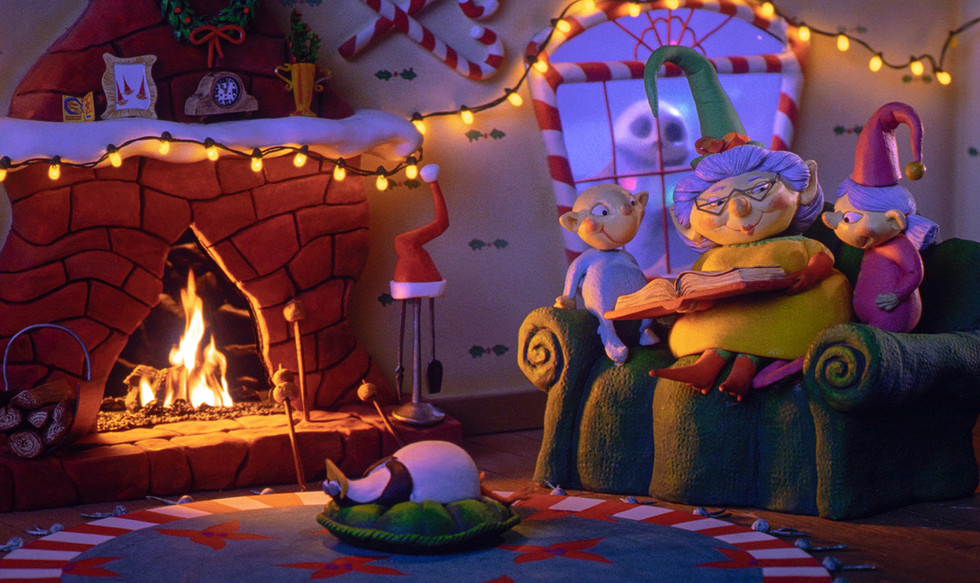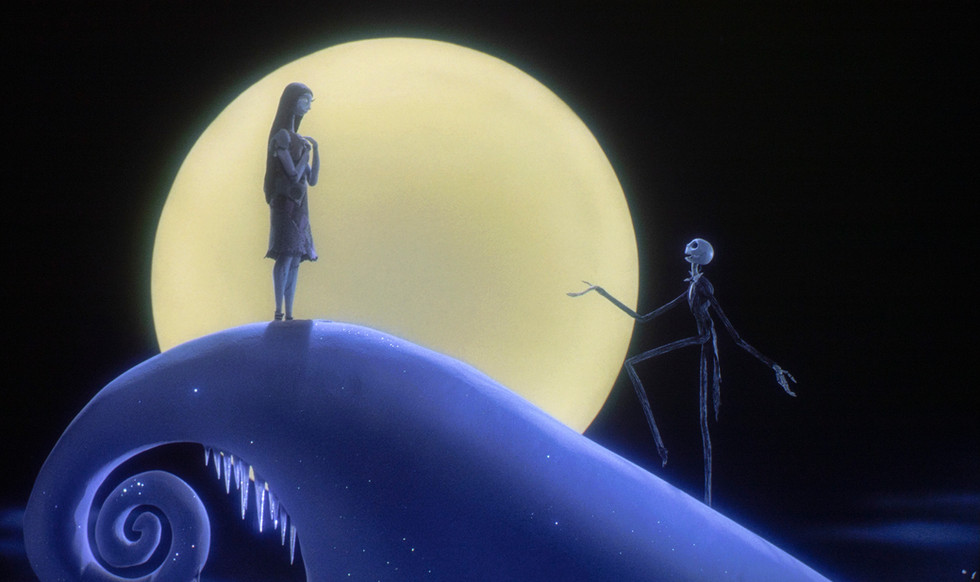Filling your dreams with delight: “The Nightmare Before Christmas: 30th Anniversary Edition”
- Bill Kelley III

- Aug 25, 2023
- 6 min read
4K ULTRA HD REVIEW / HDR FRAME SHOTS
Skeleton Jack Skellington (Chris Sarandon) has Santa (Edward Ivory) abducted from Christmas Town and plans to be the jolly Kris Kringle on Christmas Eve.
(Click an image to scroll the larger versions)
“THE NIGHTMARE BEFORE CHRISTMAS: ULTIMATE COLLECTOR’S EDITION”
4K Ultra HD, Blu-ray, Digital copy; 1993; PG for some scary images; Streaming via Amazon Prime (4K), Apple (iTunes) 4K, Movies Anywhere (4K), Vudu (4K), YouTube (4K)
Best extra: Tim Burton’s original poem narrated by Christopher Lee
WALT DISNEY STUDIOS has released a stunning 4K restoration of Tim Burton’s stop-motion animated wonder, “The Nightmare Before Christmas,” for its 30th anniversary.
Glad tidings for all!
Animated films are mostly computer-generated in today’s cinema, a process that began with Pixar’s “Toy Story” (1995). Previously, they were drawn by hand going back to Walt Disney’s first animated feature “Snow White and the Seven Dwarfs” (1937) and continued into the early 1990s with the much-loved animated musicals “The Little Mermaid” 1989, “Beauty and the Beast” (1991) and “The Lion King” (1994). “Nightmare” used stop-motion, in which miniature characters were constructed, then moved in tiny increments, frame by frame, for three painstaking years, to create Burton’s outrageous three-dimensional characters. As a child, he had always been amazed by the stop-motion holiday classic “Rudolph the Red Nosed Reindeer” (1964).
The genesis of the cult classic was Burton watching a store window change from Halloween decorations to Christmas decorations. “It triggered an idea for a story,” he said before introducing Christopher Lee on the enclosed Blu-ray. Burton wrote “Nightmare” as a three-page poem in 1982, while an animator for Disney. After directing “Pee-wee’s Big Adventure” (1985), “Beetlejuice” (1988), and “Batman” (1989), Burton still had an option with Disney to develop “Nightmare.” He originally felt it could be a short film or a TV special along the lines of “How the Grinch Stole Christmas” (1966).
Halloween Town
(1) “This, our town of Halloween. This is Halloween, this is Halloween. Pumpkins scream in the dead of night. This is Halloween, everybody make a scene trick or treat.” (2) Everyone celebrates another successful Halloween. “It’s our most horrible yet,” says Jack. (3&4) Silhouetted against the bright moon Jack sings - Jack’s Lament “I, Jack the Pumpkin King have grown so tired of the same old thing.” (5) Ghosts appear from the pumpkins. (6) Patched-up rag doll Sally (Catherine O’Hara) watches Jack from the Halloween Town graveyard.
Preproduction of Burton’s fairy tale started in 1990 in a San Francisco warehouse, with his old college friend at CalArts’ animation and former-Disney animator Henry Selick (“James and the Giant Peach,” “Coraline”) as director. Known as a stop-motion master, Selick supervised 13 brilliant animators and 100 specially trained camera operators, puppet makers, and set builders. “The concept is his [Burton], the main characters, the tone, the look,” Selick explains. The production filled 19 soundstages with 230 miniature sets, hundreds of individual puppet characters, and thousands of different heads with hundreds of distinctive expressions.
Burton recruited Danny Elfman, the former frontman of the New Wave band Oingo Boingo, to compose and write the 11 operatic-styled songs and seven pieces of film score the late Chicago Sun-Times “At the Movies” film critic Roger Ebert called, “So clever they could be updated from Gilbert & Sullivan.” A written script wasn’t available at that time, so Burton gave Elfman oral descriptions and drawings to help compose the songs.
Then storyboards were created and assembled with the music before the actual puppet animation stage would be captured on 35mm film cameras at 24 frames per second. That’s 24 shots to produce one second of on-screen footage. “The storyboard provided timing, action, gestures, the whole attitude to each scene,” says art director Deane Taylor. The overall art design was based on Burton’s first film “Vincent,” a short stop-motion horror voiced by Vincent Price, merging the look of German Expressionists and Dr. Seuss, Selick says. Ebert also agreed with “Nightmare’s” assessment of the visual worlds he first saw in the silent German Expressionist masterpieces “The Cabinet of Dr. Caligari” (1920) and “Metropolis” (1927). “What all of these films have in common is a visual richness, so abundant that they deserve more than one viewing,” Ebert says.
Christmas Town
(1&2) Jack stumbles upon the holiday tree portal to Christmas Town. (3) The glowing bright lights of Christmas Town. (4-6) Jack sings “What’s This?” and discovers his first snowflake, a snowman, and a family snuggled by the fire. (7) Jack returns to Halloween Town and shows Sally the Santa outfit he wants her to make.
The story begins in dark, monochromatic Halloween Town as the residents celebrate another successful fright night. The spiritual head of town is skeleton Jack Skellington, voiced by Chris Sarandon with Elfman providing the musical vocals; patched-up rag doll Sally (Catherine O’Hara), Oogie Boogie (Ken Page), Mayor (Glenn Shadix), Dr. Finkelstein (William Hickey) and Lock (Paul Reubens). While wandering in the forest, Jack stumbles upon a series of trees painted with iconic symbols for the different holidays. He opens the Christmas tree door and falls into Christmas Town, a world of vivid color, where everyone is building toys. He’s determined to take over Christmas from the fat man he calls Sandy Claws (Edward Ivory) and bring all the joy to Halloween Town. “Christmas will be ours,” Jack declares.
The avant-garde “Nightmare” opened on October 13, 1993, receiving high marks from critics, while its box office earned a modest $50 million, landing No. 24 for the year between Arnold Schwarzenegger’s “Last Action Hero” and Disney’s “The Three Musketeers.” “Jurassic Park” and “The Fugitive” topped the 1993 box office list. “Nightmare” received one Oscar nomination for Best Visual Effects – the first for an animated film.
Interest in merchandise from the film brought "Nightmare Before Christmas" the fans it deserved.
(1) Sally is unsure of Jack’s plan for Christmas. (2) The Mayor (Glenn Shadix) of Halloween Town. (3-6) Jack assigns mischievous Lock, Shock, and Barrel to abduct Santa, but by mistake they bring the Easter Bunny. Jack gives the children a disgusting face and the children finally arrive at the door of Santa Claus.
EXTRAS The enclosed Blu-ray ported over from the 25th Anniversary “Sing Along Edition” houses all the bonus features. The best of the bunch is the stirring reading of Burton’s original poem by the late Christopher Lee (“The Lord of the Rings Trilogy”) with illustrations based on his original concept art. Another fine addition is the 24-minute, six-part "Making of" documentary with interviews from Burton, Selick, and Elfman, in which the trio provide an in-depth running commentary. The disc also includes “Storyboards-to-Film” comparisons, deleted sequences, Burton’s early short film “Frankenweenie” in standard-def, and a tour of the seasonal Haunted Mansion ride at Disneyland with “Nightmare” characters and music.
VIDEO
The original 35mm camera negative (1.66:1 aspect ratio) stored at Disney’s vaults was scanned in 4K and restored in TRUE 4K for an impressive presentation with excellent clarity – especially those wide expressionist set pieces and the close- up costume textures. And yes, there is plenty of natural film grain with no signs of digital noise reduction, a black eye in Disney’s restoration work a decade earlier. “Because they had the original negative, I knew that there was that much more visual information to be had,” Selick said during a recent interview with A.Frame Magazine, a digital publication from the Academy of Motion Pictures Arts and Sciences.
The HDR10 (4K disc) and Dolby Vision grading (digital platforms) increase its cinematic look compared to the SDR grading on the Blu-ray. There’s a slight uptick in overall color fidelity, with the highlights and mid-tones more controlled showing more detail and shading. You will not be disappointed.
The 4K encoding is on the smaller 66 GB disc, but with a running time of just 76 minutes and the video bit rate still varies from 60 Megabits per second to over 100 Mbps.
AUDIO
The 4K and Blu-ray carryover the previous eight-channel 7.1 DTS-HD Master, with its strong bass response and overall wide soundstage from front to the sides and rear speakers. Vocals and dialogue are never lost within Elfman’s music.
Hat’s off to Disney as “The Nightmare Before Christmas” makes 2 for 2 with this year’s earlier release of “Cinderella” (1950), preserving the original 35mm film grain structure and clarity for top-grade 4K Ultra HD presentations.
— Bill Kelley III, High-Def Watch producer


























































Comments